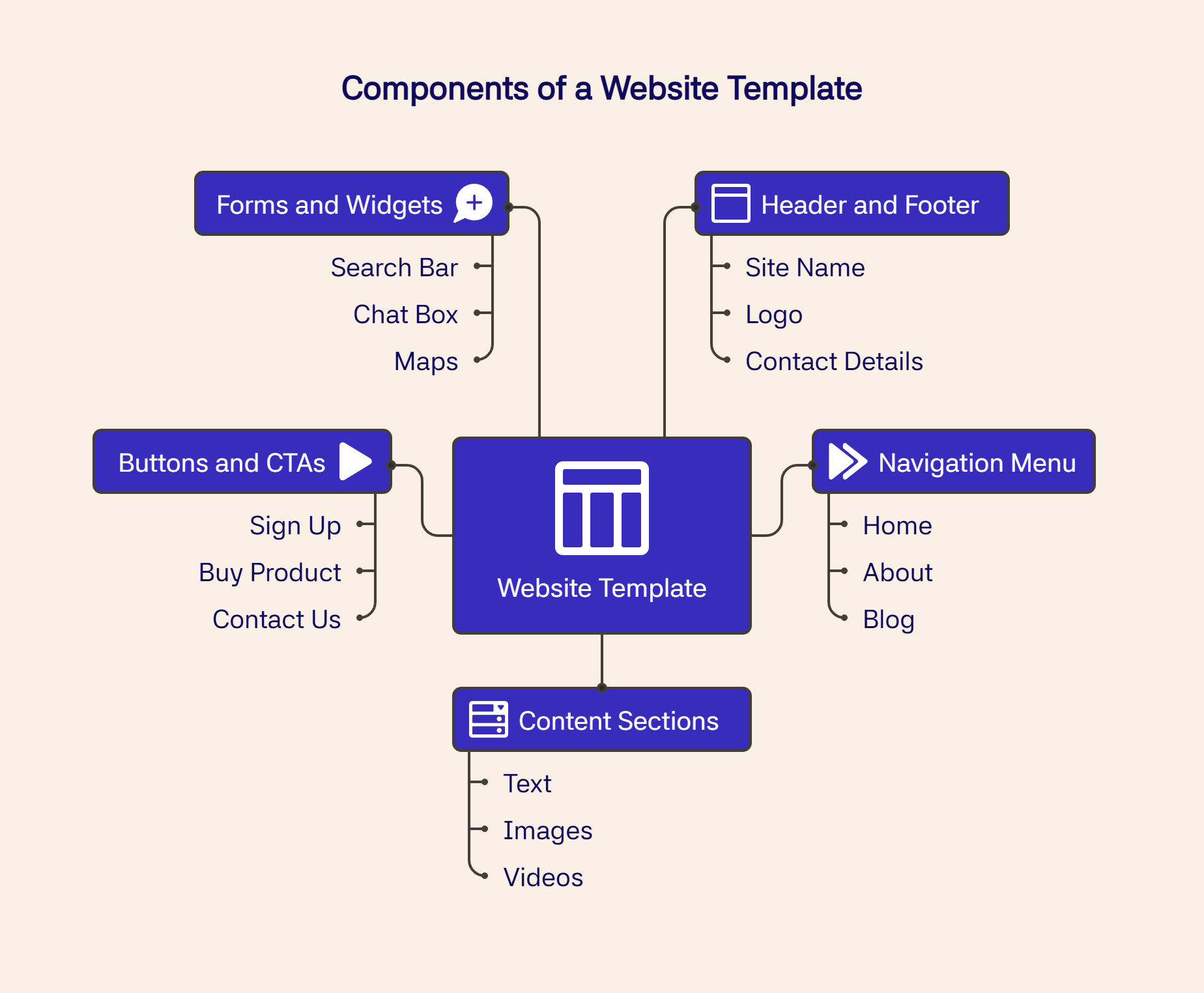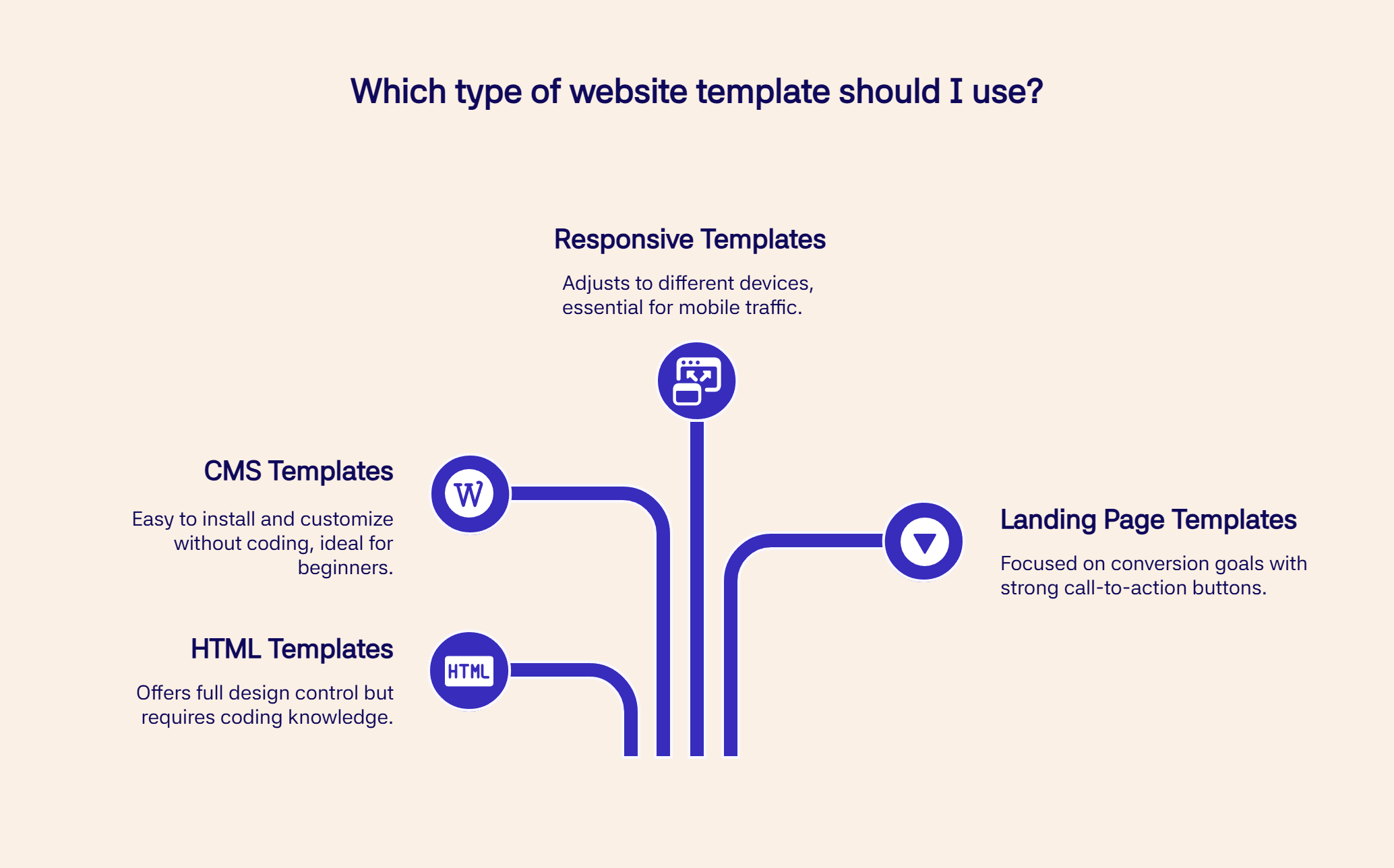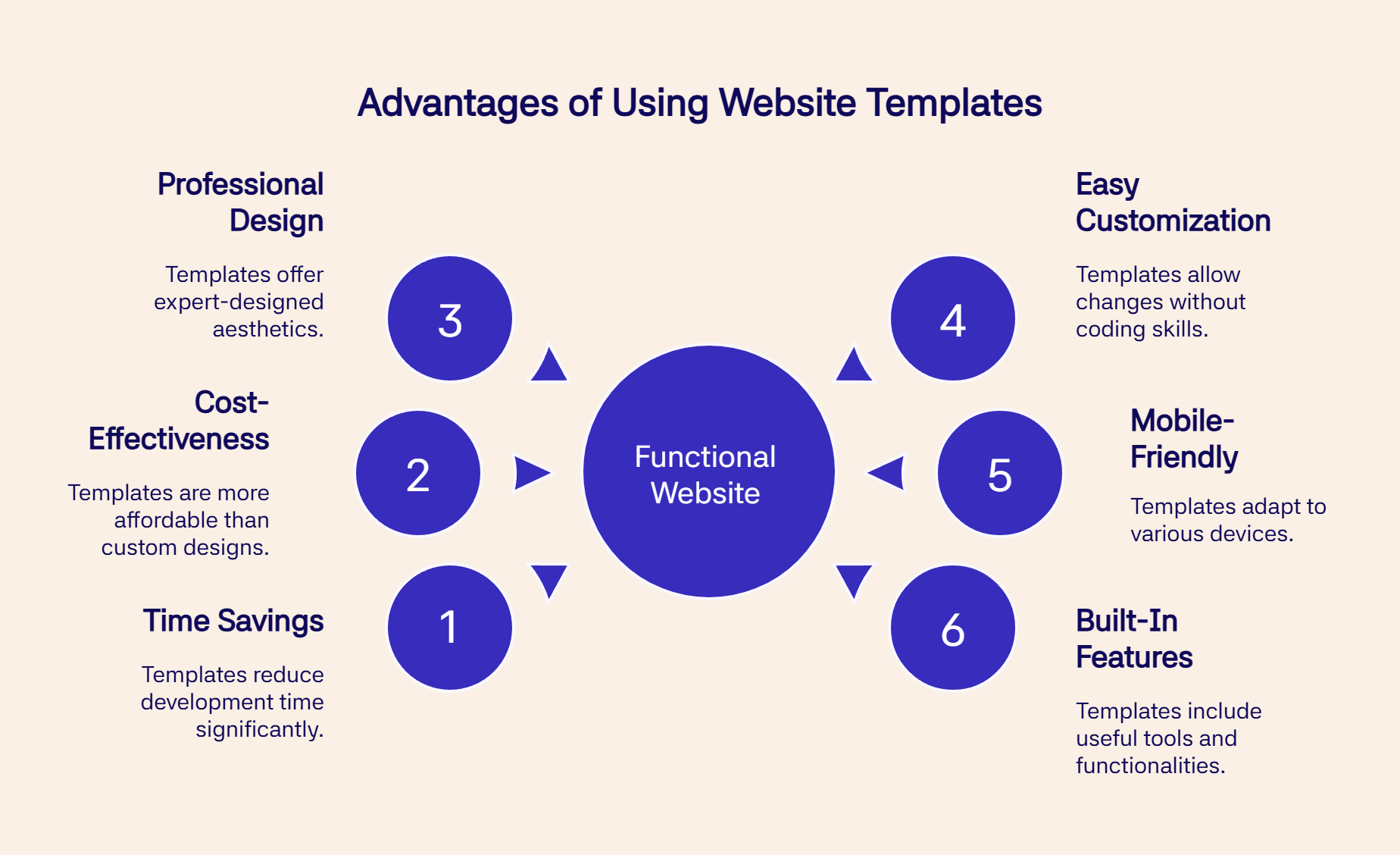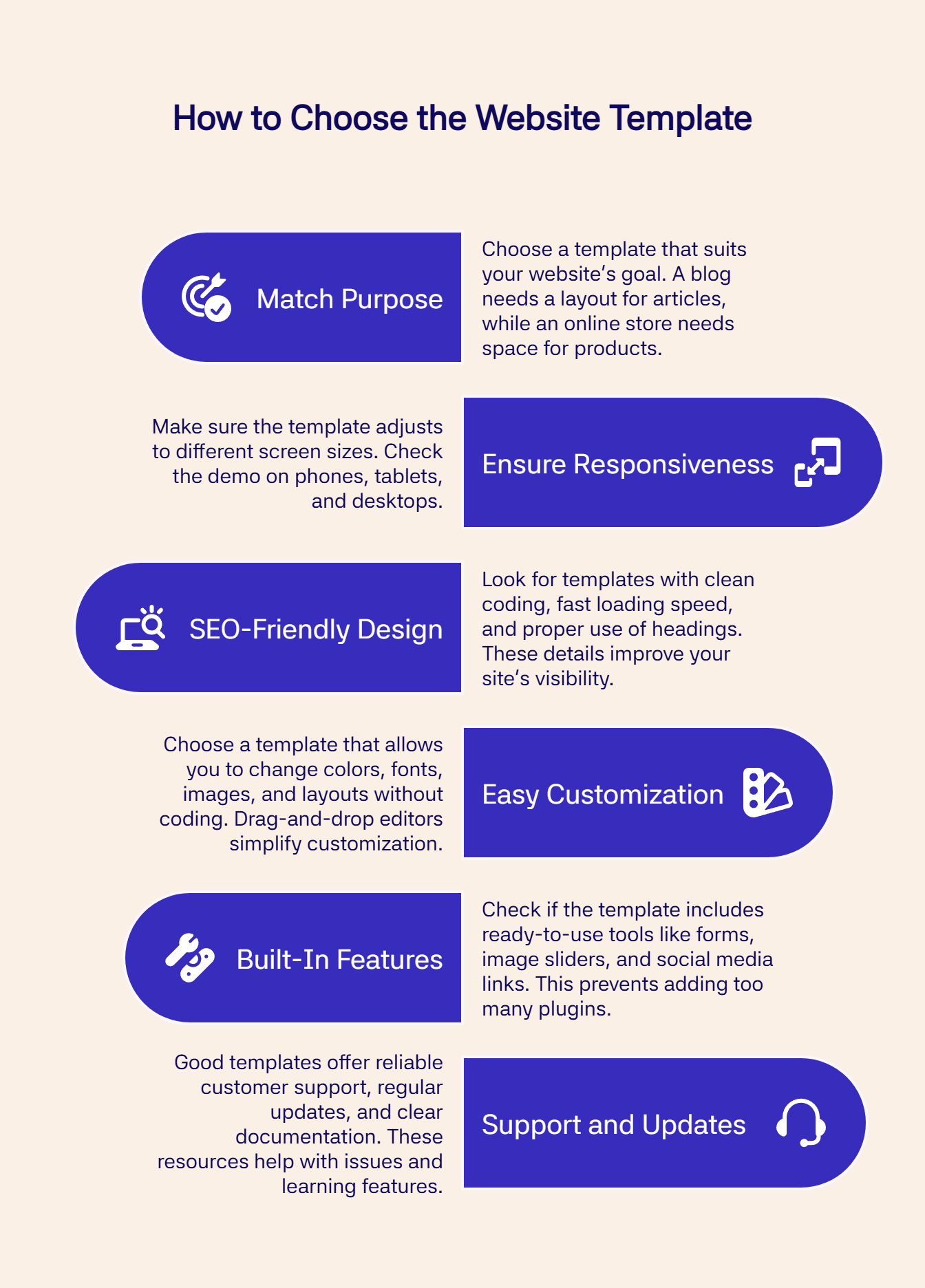A website template is a pre-designed layout that provides a ready-made structure, colors, and features to build a website quickly. Templates save time, reduce costs by 50–70% compared to custom sites, and ensure a mobile-friendly design. Over 51% of websites today rely on templates for a professional and responsive online presence.
In this guide, you’ll learn what a website template is, why it matters, and how it can save you time, money, and effort while giving your site a professional edge.
TL;DR:
-
Website templates are pre-designed layouts that reduce website development costs by 50-70% compared to custom sites
-
Over 51% of websites today use templates, with the market expected to grow from $1.3 billion to $2.2 billion by 2028
-
Templates include essential components like headers, navigation menus, content sections, CTAs, and forms for complete functionality
-
Responsive templates automatically adjust to mobile devices, crucial since 60.4% of web traffic comes from mobile users
What Is A Website Template?
A website template is a ready-made design that lets anyone build a website quickly. It gives you layout, colors, and structure, all set up for you to add your own text and images.
Using a template is cost-effective. According to BeBusinessed, in 2023, the website template market was worth about US $1.3 billion, and it is expected to grow to US $2.2 billion by 2028. Nearly 51% of all websites rely on templates today.
Many small businesses use templates to save both time and money. Templates can cut design costs by 50-70% compared to building a custom site.
However, website templates are usually made for specific usages. For example:
Devloop is made by Dorik for agency websites. This template includes all the necessary sections that an agency usually wants to showcase to its visitors. It has several pages signed to highlight cases, blogs, and the Agency.
Cuisine is an aesthetic restaurant-themed website template. It showcases lots of beautiful media to convert visitors into customers. It has several pages specifically for menus, chefs, logs, and reservations.
Dorik’s personal portfolio is suitable for people who provide solo digital services. Whether you are a freelance web designer or copywriter, you can use this portfolio website to showcase your work to impress your potential clients.
Similarly, builders create templates for various purposes that allow people to utilize them for their specific needs with website personalization.
Components of A Website Template
A website template is made up of several building blocks, which are known as template components. Each block has its own role in shaping the look and function of the site.

Among them, 5 components are the most common for any website.
1. Header and Footer
The header appears at the very top of every page. It usually carries the site name, logo, and sometimes a menu. The footer stays at the bottom and often includes contact details, copyright notes, social media links, or quick navigation. Together, they frame the entire site.
2. Navigation Menu
This is the roadmap for visitors. A clear menu helps people jump between pages like Home, About, Blog, or Shop. Without good navigation, users may feel lost and leave the site. In fact, 94% of users say easy navigation is the most important website feature.
3. Content Sections (text, images, videos)
These sections make up the main body of the website. They share your story, explain your services, and show visuals. A mix of text, images, and videos keeps the content engaging and easy to understand.
4. Buttons and CTAs (Call to Actions)
Buttons guide visitors toward an action, such as signing up, buying a product, or contacting you. Strong CTAs give direction and increase the chances of reaching your goals. Research shows that a single clear CTA can boost conversions by over 371%.
5. Forms and Widgets
Forms collect useful information like emails or questions. Widgets add handy tools such as search bars, chat boxes, or maps. These features make the website more interactive and user-friendly.
Different Types of Website Templates
Website templates are not all the same. They come in different types, each serving a unique purpose.

Here are the 4 most common template types:
HTML Templates
HTML templates are built using coding languages like HTML and CSS. They give you full control over design and layout. These templates are often fast and lightweight, but may need some coding knowledge to edit.
CMS Templates
CMS in web design stands for Content Management System. Popular platforms like WordPress, Dorik, Joomla, or Drupal use these templates. They are easy to install and customize without coding, which makes them perfect for beginners and bloggers.
Responsive Templates
A responsive template adjusts itself to different devices. Whether someone visits your site on a phone, tablet, or desktop, the design looks clean and easy to use. This type is essential today because over 60.4% of global web traffic comes from mobile devices.
Landing Page Templates
Landing page templates are designed for one goal, like collecting emails, selling a product, or promoting an event. They are simple, focused, and often include strong call-to-action buttons to convert visitors quickly. Businesses using landing pages see up to 55% more leads.
Why Should You Use A Website Template?
Website templates have become the first choice for both beginners and small businesses. They take away the stress of starting from zero and offer a simple path to building a functional site.

Among so many benefits, 6 major advantages of using a template impress the most users:
Saves Time on Design and Development
Building a custom website can take a very long time. From planning the layout to coding every part, the process often stretches into weeks. A template removes this problem by giving you a ready-made structure.
With just a few edits, your site can be live in hours instead of months. In fact, research shows that using templates can reduce development time by up to 60%.
Cost-Effective Compared to Custom Websites
Hiring a web developer or design agency is expensive. The cost can go from hundreds to thousands of dollars. Templates, on the other hand, are affordable and often free. This makes them a great solution for small shops, bloggers, or anyone working with a tight budget.
Also, according to HubSpot, the average cost of designing a custom website ranges from $12,000 to $150,000, while using a template can reduce costs significantly, often to just a few hundred dollars or even free in some cases
Professional and Attractive Design
Most templates are designed by experts who understand style, colors, and user experience. This means your website will look clean, modern, and professional from the start. Visitors are more likely to trust and engage with a site that feels polished.
Easy Customization Without Coding Skills
You don’t need to be a programmer to make changes. Templates usually come with drag-and-drop editors or simple dashboards. You can switch images, edit text, and update colors without touching a single line of code.
Mobile-Friendly and Responsive Layouts
Today, most people browse the web on their phones. Responsive templates automatically adjust to fit mobile screens, tablets, and desktops. This ensures every visitor enjoys a smooth experience, no matter what device they use.
As mentioned earlier, over 60% of global website traffic comes from mobile devices, and that’s why responsiveness is critical.
Built-In Features and Functionality
Templates often include helpful tools like contact forms, image galleries, and social media buttons. These built-in features save extra work and add value to your site right away.
Tips for Choosing the Right Website Template
The template you choose directly affects how users experience your site, from design and navigation to speed and SEO performance. Selecting the right template determines usability, engagement, and long-term growth.

Here are 7 important tips that will help you make the right choice.
Match the Template to Website Purpose
Start by thinking about your goal. A blog needs a layout that highlights articles, while an online store needs space for products and checkout options. Matching the template to your purpose ensures your site works the way you want.
Ensure Responsiveness
People visit websites using phones, tablets, and desktops. The template of a good website should adjust automatically to all screen sizes. Always check the demo on different devices to make sure it looks clean everywhere. This is crucial because 57% of internet users say they won’t recommend a business that has a poorly designed mobile site.
Check for SEO-Friendly Design
Search engines like Google rank websites that are easy to read and load quickly. Look for templates with clean coding, fast loading speed, and proper use of headings. These small details can improve your site’s visibility online. Considering that 75% of people don’t like to scroll past the first page of search results, SEO-friendly design is a must.
Look for Easy Customization Options
You should be able to change colors, suitable fonts, images, and layouts without coding. Templates with drag-and-drop editors or user-friendly dashboards make customization simple and save you hours of frustration.
According to the Shape, 94% of first impressions are determined by the website design, so customization flexibility really matters.
Review Built-In Features and Functionality
Some templates include ready-to-use tools such as forms, image sliders, and social media links. Before choosing, check if the template has features that match your needs. This will prevent you from adding too many extra plugins later.
Consider Support, Updates, and Documentation
Good templates often come with reliable customer support, regular updates, and clear documentation. These resources are helpful when you face issues or want to learn how to use all features properly.
FAQs
What is the difference between a website and a template?
A website is a complete online presence with content, design, and functionality. A template is a pre-designed layout that acts as a starting framework to help you build and customize a website quickly.
What is the difference between a website theme and a template?
A template provides a single-page or layout structure, while a theme is a collection of templates, styles, and design settings for an entire website. Themes control the site’s overall look, and templates manage specific sections.
Which website builder has the best templates?
Many website builders offer good templates, but Dorik stands out for its clean, modern, and fully responsive designs. It provides a variety of customizable templates suitable for startups, blogs, and businesses without requiring coding skills.
End Note
The right website template helps build a functional, professional, and mobile-friendly site quickly. Templates save time, reduce development costs, and provide built-in features that improve usability and engagement for visitors.
Knowing the main components, types, and selection criteria ensures you pick a template suited to your website’s purpose. A carefully chosen template improves design consistency, navigation, and performance to make your site more effective at attracting and retaining users.





